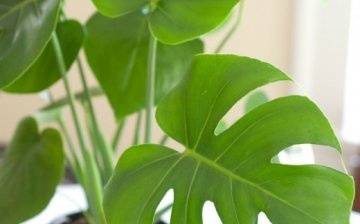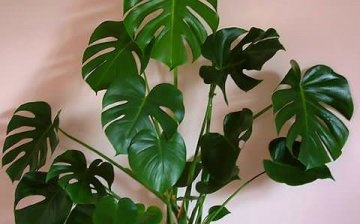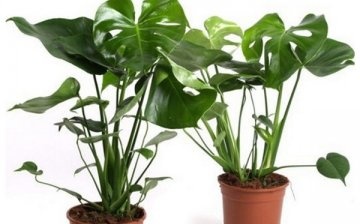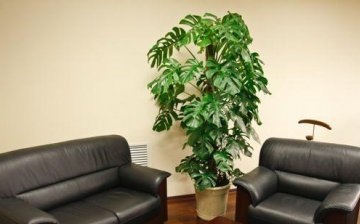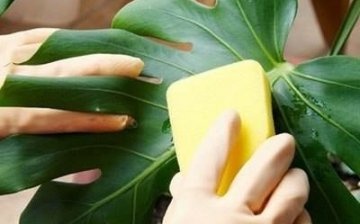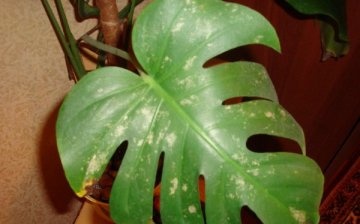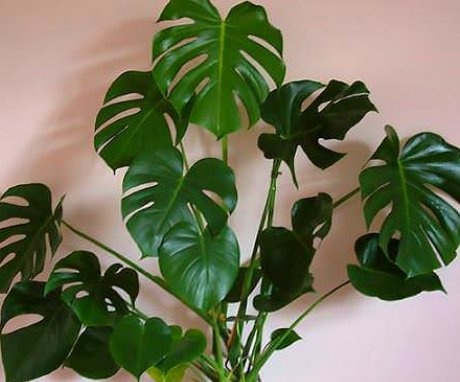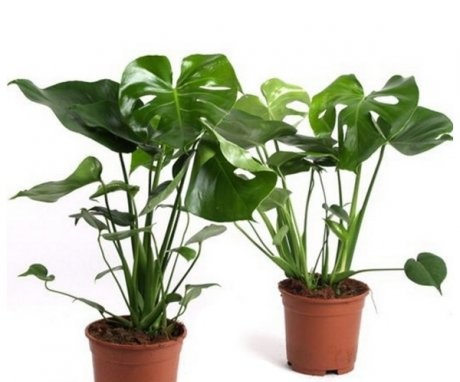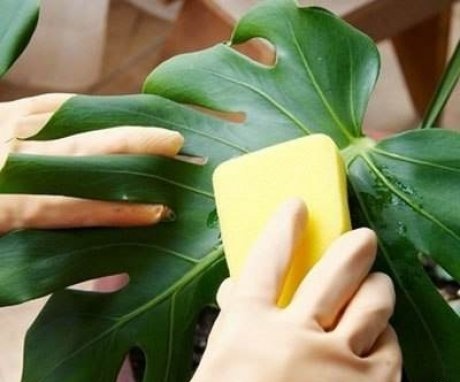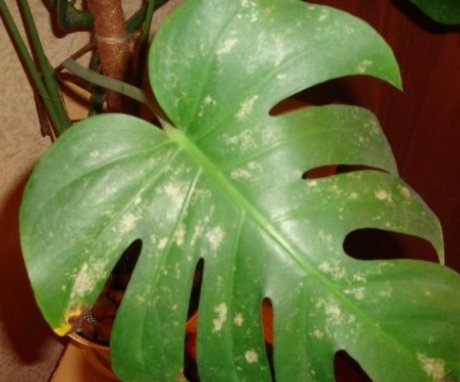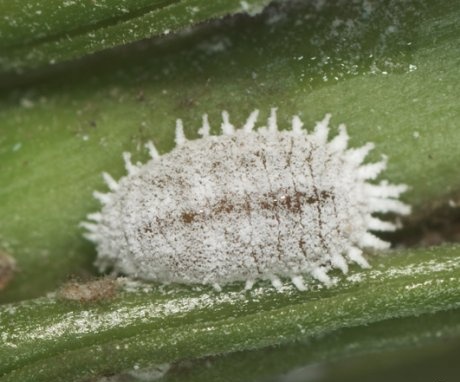Monstera: proper home care
In the tropical forests of South America, it is easy to find a liana - a monster with leaves huge a meter in diameter, with a trunk up to forty - in length. How great these giants look when flowers appear on them, reminiscent of a baby wrapped in a blanket. The fruit of the tree is also interesting, which with its juicy pulp resembles a banana-pineapple mixture. But we will talk about the indoor version of the plant.
Monsters, belonging to the aroid family, have several species. The unusual appearance of the plant gave it such an interesting name, which means something frighteningly beautiful.
Content:
- Description of the room monstera
- Types of plants, their features
- Conditioning: lighting, humidity and temperature
- Watering and feeding the plant
- Transplant terms and rules
- How to avoid disease and control pests
Description of the room monstera
At the end of the 17th century, English colonists brought the vine to India, from where it began its movement to the east. Nowadays, the monster can be found in various premises of residential and office purposes. Even at home, the plant justifies its belonging to the vines, reaching up to four meters in length, relying on supports during growth. Its lacy, beautifully cut dark green leaves with a diameter of about thirty centimeters have a leathery structure. And the aerial roots of the plant hang down to the ground.
Once every two years monstera gives large inflorescences, collected in a cob, around which a cream-colored bedspread is located. When ripe, the canopy stiffens, falls off, and the cobs of a purple hue, consisting of small juicy fruits pressed against each other, remain. They can be eaten as they taste good, resembling pineapple, strawberry, banana all rolled into one. You can not eat unripe ears: they can cause inflammation of the oral mucosa, and in severe cases - internal bleeding in the organs of the digestive tract.
In indoor conditions, monstera rarely blooms.
Liana-like plant has a lot of useful properties, absorbing harmful substances, humidifying the air. It allows you to tune in to a working mood, calm down, focus on activities, so many people prefer to grow a monster in offices, halls, living rooms. And, growing rapidly, the flower creates green bushes in the middle of the house, which create wonderful places to relax under the vine.
Types of plants, their features
In indoor plant growing, not all types of tropical miracle are used, of which there are about fifty, but only some of them:
- Widely known for its use in winter gardens, the philodendron perforated, referring to the species of an attractive or delicious monstera. It is distinguished by a heart-shaped shape with huge leaves, the plate of which is deeply dissected, and as it grows, holes appear on them constantly. Even at home, the vine reaches ten meters in height.
- Borzig species has medium-sized leaves on thin stems.
- The oblique monstera, or expilata, is characterized by whole leaves with large oblong holes.
- A hole-in-one or punctured monstera has light green foliage in the shape of an egg with cuts all over the surface.
All species can be grown at home and are classified as climbing vines. The difference between species in the structure of leaves, the shape of the cobs, their size.
Conditioning: lighting, humidity and temperature
As an alien from the tropics, the monstera prefers to live in conditions that remind her of her homeland. Lianas can be found in sunny glades in the shade of the trees along which they weave. The wide leaves of the plant are afraid of the bright burning rays of the sun, but it is also difficult for them to grow in the dark, they can decay, lose their decorative effect. Having picked up such a place in a room where partial shade reigns, it is advisable not to move the pot with the plant to other areas of the house. It is very moody, does not like drafts, touches from which it begins to cry - this is noticeable by the droplets of moisture on the leaves.
The creation of a tropic microclimate indoors will make it possible for the monster to delight not only with the bright green foliage, but with the appearance of interesting inflorescences.
Moist air is very necessary for liana, especially its leaves. They, evaporating moisture, require its compensation, so they must often be wiped with a damp cloth, maybe even soaked in water half and half with milk. This will only increase the radiance of the huge green palms.
Adoring warmth, the monstera is responsive to it, trying to gain strength at temperatures above twenty degrees, productively, intensively developing. She is not afraid of a drop in temperature, but she cannot stay cool for a long time. At this time, the growth of the flower slows down, it is in relative rest, freezes until summer comes again.
Watering and feeding the plant
For those who do not really like to tinker with capricious indoor flowers that require special care, the liana is perfect:
- During the period of active growth, from March to October, it is necessary to water the plant often, making sure that the water does not stagnate. As soon as the topsoil begins to dry out, it means that you need to give it water. In winter, when the growth of the monstera freezes, the frequency of watering is reduced. Particular attention should be paid to the water that is used for this procedure: it should not come from the tap, it should be left to stand for some time so that the liquid reaches room temperature.
- Top dressing monsters spend about twice a month using complex fertilizers such as Humisol. They are introduced into the soil along with subsequent irrigation. It is also recommended to use the foliar feeding method. Urea is diluted in water, and the bush is sprayed with this solution. During the dormant period, the vine does not need feeding. For a young flower, watering with an infusion of onion husks, which is prepared from a handful of raw materials and a liter of boiling water, will be sufficient.
- The aerial roots of the creeper require additional care; in no case should they be trimmed: they provide nutrition to the plant. They can be simply tied to a trunk or wrapped in damp moss. From this, the state of the indoor flower will only improve.
These simple tips will help in proper care of the monster, allowing it to have bright green leaves, covered with droplets of moisture in wet weather.
Transplant terms and rules
Monstera usually grows from a simple cut, and, being in infancy, needs an annual transplant with the transition to a larger pot. The best time for this will be autumn, when the growth of the vine slows down, and she prepares for winter rest.
The capacity for a plant is selected taking into account that a powerful root system creepers fit in it freely. It should be reasonably wide and deep. A third of the pot is covered with a drainage layer consisting of expanded clay or fine gravel. The rest is filled with soil mixture, which includes three parts of sod land, equally one part of peat, humus, sand.For this purpose, you can purchase ready-made soil intended for aroids in a specialized store.
The method of transplanting monstera is by transshipment, in which clods of earth remain on the roots. Before that, it is abundantly watered several times so that the lump of soil is moist. Grasping the trunk of the plant, place it in the center of the prepared container, filling the voids with soil, lightly tamping it.
For plants over four years old, the transplant should be carried out less often - after three to five years.
But every year they renew the top layer of the soil, pouring it enriched with minerals and organic soil composition. During transplantation, to rejuvenate the vines, it is necessary to cut off the top, on which there are two or three internodes, leaves. After such a procedure, lateral shoots will begin to actively develop. And the top, placed in water or placed in moist soil, can be put into propagation, subsequently obtaining another plant.
How to avoid disease and control pests
The main problems of the plant are associated with improper care of it:
- Yellowness, pallor of monstera leaves indicates excessive moisture, and the appearance of brown spots indicates, on the contrary, insufficient watering... In the first case, the frequency of watering procedures is reduced, in the second, they are increased.
- If the leaves of the creeper have become translucent, cast yellow, it is urgent to look for another place for the plant, here the sun's rays are too bright for it, they burn it.
- With insufficient lighting, the leaves lose their delicacy, become unattractive, and the trunk becomes bare.
- Monstera reacts to dry air in the room with the appearance of dried leaf tips. To get rid of this, you can put a container of water next to the pot.
- The brownness of the leaves during the dormant period suggests that it is necessary to reduce the moisture content of the soil in the container.
With constant observation of the tropical beauty, it is possible to respond to the signals given by the leaves with adequate care actions.
Harmful insects often attack the monster, they like its juicy green leaves with a moist surface:
- An insect with a waxy coating similar to the shell of a turtle, the scale insect settles on all parts of the houseplant. All year round, both larvae and adults are harmful, sucking juices. After that, the plant begins to dry out, turn yellow, and the leaves fall off at the same time. Having carefully examined the diseased indoor flower, it is necessary to remove parasites from it with a cotton swab dipped in an insecticidal solution. You can use alcohol or kerosene for this purpose. Such methods are effective, but can cause leaf burns. After processing the plant, wash the monstera with infusion of tobacco or laundry soap. They complete the fight against the shield by spraying the entire bush and soil with an insecticidal agent.
- The spider mite is easy to recognize by its whole body with six to eight pairs of legs, its species differ from each other in color, in which there can be red, yellow, green shades. The parasite is active in dry air with a high indoor temperature. The appearance on the plant of a thin web encircling it indicates the settlement of the mite. Treatment of monstera with toxic drugs will help to cope with the pest. These means include Aktellik, Marshal. The solution is used to treat the liana so that it is completely moistened with it. The number of procedures reaches three, carried out with an interval of five days. According to the rules, only dry plants can be sprayed in the first half of the day at temperatures above twenty degrees. Do not forget about personal safety, thoroughly washing your hands, face, rinsing your throat, nasal cavities after the treatment session.
- It is very difficult to notice the thrips moving quickly through the parts of the indoor flower, striking them from the inside. You can detect the pest by examining the leaves of the monstera, when black dots or stripes are visible on them.If you do not fight the parasite, the leaves will look like translucent gauze. To prevent insect infestation, it is necessary to hang sticky traps, regularly wipe the monster with a damp cloth, and spray. When thrips are found, the diseased vine is separated from healthy specimens, and the affected areas are removed from it. It is best to transplant the plant into a different pot by changing the soil mixture. Only periodic spraying with combined preparations will save the tree, as well as watering, wiping the leaves, trunk with soapy water, followed by washing off every other day.
- The name mealybug tells us about the appearance of the parasite, which seems to be sprinkled with flour. From it, a white bloom appears on the plants, similar to pieces of cotton wool with a characteristic stickiness. Monstera, when attacked by a worm, stops developing, losing old leaves, with the deformation of young ones. If the pest has infected the root system, then it begins to rot. You can clean the plant from the worm with a cotton swab dipped in a soap solution. Then sprinkle with Green soap three times with a break of ten days. Insecticides Aktara, Fitoverm, liana transplant will also help.
Indoor liana - monstera is the best gardener of any kind of premises, having a positive effect on well-being, human performance, ionizing the air.
More information can be found in the video:



